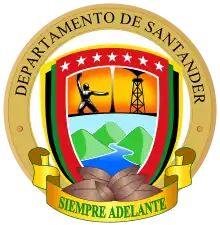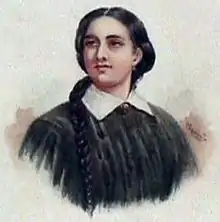Santander Department
Santander (Spanish pronunciation: [santanˈdeɾ]) is a department of Colombia. Santander inherited the name of one of the nine original states of the United States of Colombia. It is located in the central northern part of the country, borders the Magdalena River to the east, Boyacá to the south and southeast, the Norte de Santander Department to the northeast, the Cesar Department to the north, the Bolivar and Antioquia Departments to the west. Its capital is the city of Bucaramanga.
Department of Santander
Departamento de Santander | |
|---|---|
 Coat of arms | |
| Motto(s): Santandereanos siempre adelante (Spanish: People of Santander always ahead) | |
| Anthem: Himno de Santander | |
.svg.png.webp) Santander shown in red | |
 Topography of the department | |
| Coordinates: 7°8′N 73°0′W | |
| Country | |
| Region | Andean Region |
| Established | May 13, 1857 |
| Capital | Bucaramanga |
| Largest city | Bucaramanga |
| Government | |
| • Governor | Didier Alberto Tavera Amado (2016-2019) (Liberal Party) |
| Area | |
| • Total | 30,537 km2 (11,790 sq mi) |
| • Rank | 12th |
| Population (2018)[1] | |
| • Total | 2,184,837 |
| • Rank | 6th |
| • Density | 72/km2 (190/sq mi) |
| Time zone | UTC-05 |
| ISO 3166 code | CO-SAN |
| Provinces | 8 |
| Municipalities | 87 |
| HDI (2019) | 0.778[2] high · 6th of 33 |
| Website | gobernaciondesantander.gov.co |
History
Pre-Colombian era
Prior to the arrival of the Spaniards, the territory now known as Santander was inhabited by Amerindian ethnic groups: Muisca, Chitareros, Laches, Yariguí, Opón, Carare and Guanes.
Their political and social structure was based on cacicazgos, a federation of tribes led by a cacique, with different social classes. Their main activity was planting maize, beans, yuca, arracacha, cotton, agave, tobacco, tomato, pineapple and guava, among others. Their agricultural skills were sufficiently developed to take advantage of the different mountainous terrains. The Guanes utilized terraces and an artificial system of irrigation. They had a knowledge of arts and crafts based on ovens to produce ceramics. They had cotton to make clothing and accessories such as hats and bags.
Colonization
Spanish conqueror Antonio de Lebrija led the first expedition through the area in 1529. The area was later invaded c. 1532 by German Ambrosius Ehinger in a quest to find El Dorado. This disrupted or destroyed many of the Amerindian villages. Some ethnic groups like the Yariguíes, Opones, and Carares fought the conquerors until they became extinct. Explorer Gonzalo Jiménez de Quesada later went to the area in an effort to appease the tribes. The colonization process in the area was started by Martín Galeano who founded the village of Vélez on July 3, 1539 and Pedro de Ursúa and Ortún Velázquez de Velasco founded the village of Pamplona (now part of the Norte de Santander Department) in 1549.
Once the Amerindian tribes were dominated, the Spanish organized the territory based on Cabildos (councils) to maintain the dominance and administer justice in the conquered territory. Amerindians were assimilated and subject to the encomienda regime to work in agriculture, manufacturing goods, and mines. These two villages functioned as centers for the Cabildos' territories. In 1636 the Cabildo of Vélez was transferred to a new jurisdiction centered on the village of Girón, comprising from the Sogamoso River, and Río del Oro to the Magdalena River. The village of San Gil was created in 1689, segregated from the Jurisdiction of Vélez. In 1789 the village of Socorro was also segregated from Vélez and they were all put under the mandate of the Province of Tunja, a subdivision of the Viceroyalty of New Granada. On July 9, 1795 the corregimiento of Vélez – San Gil – Socorro was created due to the unsustainability of the Province of Tunja, and local government was established in the village of Socorro.
Culture
| Year | Pop. | ±% |
|---|---|---|
| 1973 | 1,127,999 | — |
| 1985 | 1,511,392 | +34.0% |
| 1993 | 1,811,741 | +19.9% |
| 2005 | 1,957,789 | +8.1% |
| 2018 | 2,184,837 | +11.6% |
| Source:[3] | ||
During the colony and independence war times, people from Santander were specially recognized for their bravery in battle and their policy of "not even a step back". Soldiers from Santander were valued and respected but also difficult to control as they were, in general, more politically aware than people from other regions and therefore prone to question orders and law. Nowadays, they still retain those features as 'Santandereanos' are normally depicted as cranky and stubborn, not afraid of anything, proud in extreme and speaking their minds without further consideration. However, people from Santander are also very gentle and kind, have some social conventions of basic etiquette like saying hello first if you are the one arriving and never visiting someone for the first time without a small present. In general, they are normally warm and respectful, but try not to make them angry.
Cuisine
Santander cuisine includes regional specialties and food from the Department's capital city of Bucaramanga and other cities such as Cepita.
The most famous dishes are sancocho, oreada (dried cured beef), mute, egg broth, yellow arepa, masato, guarapo, aguapanela, tamale, and the exotic culona ants.
Goat
Usually accompanied by pepitoria and yellow arepa, it can be eaten fried, oven-baked, or dried.
Arepa Santandereana
Flat corn bread. This dish includes chicharron (pork belly-fat) and cooked peeled corn. When possible, the peeled corn is roasted in clay pots, to provide even more flavor.
Mute
A soup prepared with a variety of ingredients such as red meat, tripe, beef ribs, grains, potatoes, pasta, corn, and spices. Due to the ingredients included, it has a thick consistency.
Pepitoria
Pepitoria is prepared with the intestines of a goat or lamb. Served with rice, yuca, and potatoes.
Santander tamale
The tamale is a dish that is eaten in various parts of Colombia, but in Santander it is prepared with peeled corn dough and filled with beef, chicken or pork, chickpeas, onions, and paprika. It is then wrapped in banana leaf giving it a rectangular shape.
Oreada meat
This is a marinated, salted, sun-dried beef ready to grill. It is a classic dish that can be found in many restaurants as a specialty, served with yucca and chili.
Hormigas Culonas (Big Bum Ants)
A traditional dish of the Guane indigenous inhabitants of this region. The head, wings, and legs of these giant ants are removed, leaving the body and bum to be fried and seasoned with salt.
Bocadillo Veleño
Created in the town of Vélez, the Veleño Sandwich is prepared with the pulp of ripe Guava and is wrapped in a bijao leaf, giving it a characteristic flavor. It is sometimes paired with goat cheese.
Broth
A soup prepared with water, potatoes, toast, coriander, and egg (no milk or cream) and enjoyed for breakfast or lunch. There is also a variation called changua or chingua, which is normally prepared with water, potatoes, milk, cream and coriander. Sometimes broth (caldo) and changua comes with chicken or beef. Not to be confused with ajaco, which is eaten in Bogota with creamy potato, huascas (green herb) and shredded chicken.
Obleas wafers
The wafer is a superfine cookie that is spread with Arequipe (caramel, sweetened milk spread). Over time, other ingredients such as cheese, blackberry, chocolate, etc. have been incorporated.
Masato
Masato is a fermented drink that is prepared with rice, water, wheat flour, sugar, cloves, and cinnamon. All this together forms a desired drink to accompany fritters or meat patties.
Chorizo from the San José Valley
12 km from San Gil, on the road that leads to Charalá, you will find a town called Valle de San José. People from this region say this is the best Colombian Chorizo, but people from Santa Rosa de Cabal, in the Coffee Zone, will tell you the same.
Beverages
Artists
Among the most outstanding and representative artists of the Colombian Santander Department are Segundo Agelvis, Mario Hernández Prada, Carlos Gómez Castro, Martín Quintero, Oscar Rodríguez Naranjo and Pacheco de Suratá.
Notable people

- Manuela Beltrán (1724-??) a Neogranadine woman who organized a peasant revolt against excess taxation in 1780
- Juan Eloy Valenzuela y Mantilla, (Spanish Wiki) (1756-1834) a Colombian priest and botanist, worked on the Royal Botanical Expedition to New Granada which classified plants and wildlife.
- María Antonia Santos Plata (1782 in Pinchote – 1819 in Socorro, Santander) was a Neogranadine peasant, rebel leader and heroine
- Geo von Lengerke (1827 − 1882) was a German engineer, merchant and landowner.
- Ofelia Uribe de Acosta (1900 in Oiba – 1988 in Bogota) was a Colombian suffragist.
- Oscar Rodríguez Naranjo (1907–2006) a painter from Socorro, Santander Department, Colombia. His works include mainly oil paintings and sculptures
- José de Jesús Pimiento Rodríguez (1919 in Zapatoca - 2019) a Colombian Prelate of the Catholic Church
- Virginia Gutiérrez de Pineda (1921 in El Socorro, Santander - 1999 in Bogotá) was a Colombian anthropologist who pioneered work on Colombian family and medical anthropology
- Reiner Bredemeyer (1929 in Vélez, Santander − 1995) a German composer
- Carlos Ardila Lülle (1930–2021, born in Bucaramanga) a Colombian entrepreneur, founded Organización Ardila Lülle.
- Carlos Prada Sanmiguel (1939−2013) a Colombian Roman Catholic bishop.
- Patricia Ariza (born 1948 in Vélez, Santander) a Colombian poet, playwright and actor
Administrative divisions
Provinces
The department is subdivided into provinces:
Municipalities
- Aguada
- Albania
- Aratoca
- Barbosa
- Barichara
- Barrancabermeja
- Betulia
- Bolívar
- Bucaramanga
- Cabrera
- California
- Capitanejo
- Carcasí
- Cepitá
- Cerrito
- Charalá
- Charta
- Chima
- Chipatá
- Cimitarra
- Concepción
- Confines
- Contratación
- Coromoro
- Curití
- El Carmen
- El Guacamayo
- El Peñón
- El Playón
- Encino
- Enciso
- Florián
- Floridablanca
- Galán
- Gámbita
- Girón
- Guaca
- Guadalupe
- Guapotá
- Guavatá
- Güepsa
- Hato
- Jesús María
- Jordán
- La Belleza
- Landázuri
- La Paz
- Lebrija
- Los Santos
- Macaravita
- Málaga
- Matanza
- Mogotes
- Molagavita
- Ocamonte
- Oiba
- Onzaga
- Palmar
- Palmas del Socorro
- Páramo
- Piedecuesta
- Pinchote
- Puente Nacional
- Puerto Parra
- Puerto Wilches
- Rionegro
- Sabana de Torres
- San Andrés
- San Benito
- San Gil
- San Joaquín
- San José de Miranda
- San Miguel
- Santa Bárbara
- Santa Helena del Opón
- San Vicente de Chucurí
- Simacota
- Socorro
- Suaita
- Sucre
- Suratá
- Tona
- Valle de San José
- Vélez
- Vetas
- Villanueva
- Zapatoca
References
- "Estimaciones de Población 1985 - 2005 y Proyecciones de Población 2005 - 2020 Total Municipal por Área (estimate)". Departamento Administrativo Nacional de Estadística. Retrieved 16 January 2016.
- "Sub-national HDI - Area Database - Global Data Lab". hdi.globaldatalab.org. Retrieved 2018-09-13.
- "Reloj de Población". DANE. Departamento Administrativo Nacional de Estadísitica. Retrieved 6 July 2017.
.svg.png.webp)
